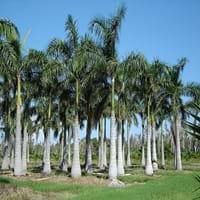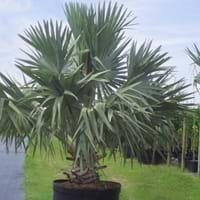Life Span
Perennial
Perennial
Type
Palm or Cycad
Palm or Cycad
Origin
Australia
Madagascar
Types
Coconut and Dates
Not Available
Habitat
tropical environments
Subtropical climates, tropical environments
USDA Hardiness Zone
Not Available
10-15
AHS Heat Zone
Not Available
12-9
Sunset Zone
Not available
H1, H2, 22, 23, 24
Habit
Upright/Erect
Oval or Rounded
Flower Color
White, Yellow
Light Yellow
Flower Color Modifier
Bicolor
Bicolor
Fruit Color
Orange, Orange Red
Brown, Chocolate
Leaf Color in Spring
Brown
Blue Green, Silver, Gray
Leaf Color in Summer
Not Available
Silver, Gray
Leaf Color in Fall
Not Available
Silver, Gray
Leaf Color in Winter
Not Available
Silver, Gray
Leaf Shape
feather-shaped
Costapalmate
Plant Season
Spring, Summer, Fall, Winter
Spring, Summer, Fall, Winter
Sunlight
Bright Indirect Sunlight
Full Sun, Partial Sun
Growth Rate
Not Available
Medium
Type of Soil
Light, Loose, Moist
Loam, Sand
The pH of Soil
Acidic
Acidic, Neutral, Alkaline
Soil Drainage
Well drained
Well drained
Bloom Time
All year
Indeterminate
Repeat Bloomer
Not Available
No
Tolerances
Not Available
Drought, Salt
Where to Plant?
Ground, Pot
Container, Ground, Pot
How to Plant?
Rooted stem cutting, Seedlings
Seedlings
Plant Maintenance
Low
Medium
Watering Requirements
Average Water Needs, Needs 2-3 times watering per week, Water daily during growing season
Average Water Needs
In Summer
Lots of watering
Lots of watering
In Spring
Moderate
Moderate
In Winter
Less Watering
Average Water
Soil pH
Neutral
Acidic, Neutral, Alkaline
Soil Type
Not Available
Loam, Sand
Soil Drainage Capacity
Well drained
Well drained
Sun Exposure
Not Available
Full Sun, Partial Sun
Pruning
Remove damaged leaves, Remove dead branches, Remove dead leaves, Remove old, faded fronds
Remove damaged leaves, Remove dead branches, Remove dead leaves
Fertilizers
Boron, EDTA iron, Maganese, Magnesium, Nitrogen, Potassium
All-Purpose Liquid Fertilizer
Pests and Diseases
Red blotch
Larva, Palmetto weevil
Plant Tolerance
Not Available
Drought
Flower Petal Number
Not Available
Single
Edible Fruit
Not Available
Yes
Fragrant Flower
Not Available
No
Fragrant Fruit
Not Available
No
Fragrant Leaf
Not Available
No
Fragrant Bark/Stem
Not Available
No
Showy Foliage
Not Available
Yes
Showy Bark
Not Available
No
Foliage Texture
Not Available
Bold
Foliage Sheen
Glossy
Matte
Invasive
Not Available
No
Self-Sowing
Not Available
Yes
Attracts
Bees, Bugs, Insects, Mice, Rats, Rodents
Hummingbirds
Allergy
Asthma, Rhinitis
Oral Cancers
Aesthetic Uses
Decorating walls, Landscape Designing, Showy Purposes
Showy Purposes
Beauty Benefits
Making cosmetics
Not Available
Environmental Uses
Air purification, Shadow Tree
Air purification
Medicinal Uses
Aging, Brain disease, Cancer, Cyanide Poisoning, High blood pressure, High cholestrol, Malaria, Metabolic disorders, Vitamin A, Weight loss
Antidepressant
Part of Plant Used
Fruits, Leaves, Tree trunks
Nut
Other Uses
Biodiesel, For making oil, Jelly, Sometimes used for making wine, Used in salads, Wax
Chewing
Used As Indoor Plant
No
Sometimes
Used As Outdoor Plant
Yes
Yes
Garden Design
Tropical
Feature Plant, Foundation, Tropical
Botanical Name
ARCHONTOPHOENIX
BISMARCKIA nobilis
Common Name
Palm
Bismarck Palm
In Hindi
Palm
Bismarck Palm
In German
Palme
Bismarck Palm
In French
Paume
Bismarck Palm
In Spanish
Palma
Bismarck Palm
In Greek
Παλάμη
Bismarck Palm
In Portuguese
Palma
Bismarck Palm
In Polish
Palma
Bismarck Palm
In Latin
Vero
Bismarck Palm
Phylum
Magnoliophyta
Magnoliophyta
Class
Liliopsida
Monocotyledonae
Family
Arecaceae
Arecaceae
Genus
Archontophoenix
Bismarckia
Clade
Angiosperms, Commelinids, Monocots
Angiosperms, Commelinids, Monocots
Subfamily
Arecoideae
Coryphoideae
Number of Species
Not Available
Properties of Palm Tree and Bismarck Palm
Wondering what are the properties of Palm Tree and Bismarck Palm? We provide you with everything About Palm Tree and Bismarck Palm. Palm Tree has thorns and Bismarck Palm doesn't have thorns. Also Palm Tree does not have fragrant flowers. Palm Tree has allergic reactions like Asthma and Rhinitis and Bismarck Palm has allergic reactions like Asthma and Rhinitis. Compare all the properties and characteristics of these two plants. Find out which of these plant can be used as indoor plant. If you are interested to decorate your house and garden, find out aesthetic uses, compare them and select the plant which will beautify your surrounding. Along with beautification, try comparing medicinal and edible uses of Palm Tree and Bismarck Palm and you can choose the plant having best and most benefits.
Season and Care of Palm Tree and Bismarck Palm
Season and care of Palm Tree and Bismarck Palm is important to know. While considering everything about Palm Tree and Bismarck Palm Care, growing season is an essential factor. Palm Tree season is Spring, Summer, Fall and Winter and Bismarck Palm season is Spring, Summer, Fall and Winter. The type of soil for Palm Tree is Light, Loose, Moist and for Bismarck Palm is Loam, Sand while the PH of soil for Palm Tree is Acidic and for Bismarck Palm is Acidic, Neutral, Alkaline.
Palm Tree and Bismarck Palm Physical Information
Palm Tree and Bismarck Palm physical information is very important for comparison. Palm Tree height is 450.00 cm and width 300.00 cm whereas Bismarck Palm height is 152.00 cm and width 610.00 cm. The color specification of Palm Tree and Bismarck Palm are as follows:
Palm Tree flower color: White and Yellow
Palm Tree leaf color: Brown
Bismarck Palm flower color: Light Yellow
- Bismarck Palm leaf color: Blue Green, Silver and Gray
Care of Palm Tree and Bismarck Palm
Care of Palm Tree and Bismarck Palm include pruning, fertilizers, watering etc. Palm Tree pruning is done Remove damaged leaves, Remove dead branches, Remove dead leaves and Remove old, faded fronds and Bismarck Palm pruning is done Remove damaged leaves, Remove dead branches and Remove dead leaves. In summer Palm Tree needs Lots of watering and in winter, it needs Less Watering. Whereas, in summer Bismarck Palm needs Lots of watering and in winter, it needs Average Water.





